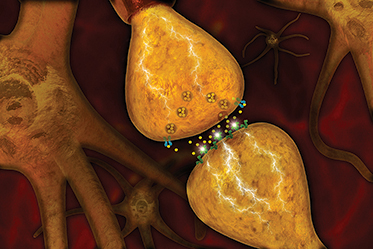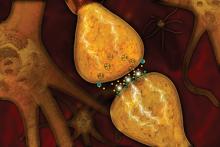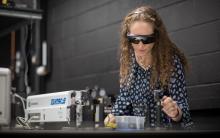
The human brain contains 30 billion neurons, and the transmission of signals through the nervous system is a complicated process involving chemistry, physics and biology. Electrophysiologist Katie Hoffman explores synaptic processes, or how cells talk to one another, focusing on how disrupting neurotransmitter signaling can alter the brain’s function.
Precise regulation of neurotransmitters, such as glutamate and acetylcholine, is crucial for processes such as learning and memory. Hoffman, professor of practice in the department of biological sciences, focuses on the brain’s hippocampus, a region important for the formation of memories.
Having joined the faculty in the fall semester, Hoffman brings to the department a background studying organophosphates, organic compounds containing phosphorus, which in low doses can be used for pesticides but in high doses are nerve agents. She came to Lehigh from the United States Army Medical Research Institute of Chemical Defense (USAMRICD), the nation’s leading science and technology laboratory in the area of medical chemical countermeasures research and development. Hoffman’s work at the Institute of Chemical Defense examined how organophosphorus nerve agents affect the ability of cells to communicate and the molecular pathways that are activated during exposure.
“That affects how the cells talk to one another,” she says. “If you treat someone with an organophosphate, you see a buildup of a neurotransmitter called acetylcholine, which can lead to seizures. But if you treat somebody with a nerve agent, how does the brain immediately respond to that prior to a seizure occurring? If we can understand what is happening to cells before the seizures start, maybe we can develop a therapy that can exploit or block some type of signaling system and mitigate the seizure severity or stop the seizure from occurring.”
Although chemicals are required to send a message from neuron to neuron, it takes a different medium to transmit that message from the receiving end of a neuron’s dendrites to its own axon terminals—electricity. When the neurotransmitters trigger the receiving neuron to fire, it sends an electrical “action potential” along its axon the way that an electrical pulse flows down a metal wire. Hoffman’s research found a depression in the cell’s electrical signaling because a mechanism occurring in the brain caused the release of a neurotransmitter to decrease before it became overexcited.
“As an electrophysiologist, I study the electrical signals, but it’s the chemical signals in the neurotransmitters that can alter how those signals are sent,” Hoffman says. “If you have a disruption to the chemical signal, that causes a disruption to the electrical signal—and that can be measured.”
Hoffman brings her research background to the classroom and has incorporated new technologies into teaching, such as the virtual reality resources found in Lehigh’s Center for Innovation in Teaching and Learning. There, she takes students inside a cell and visually demonstrates how cells work. She adds that her research background benefits undergraduate students in the laboratories.
“You want to facilitate and support undergraduate research because that’s a strength of Lehigh,” she says, “whether that be done in collaboration with another PI or we can build in a high-level question into the labs, there’s a real opportunity to integrate research into the undergraduate experience.”
































